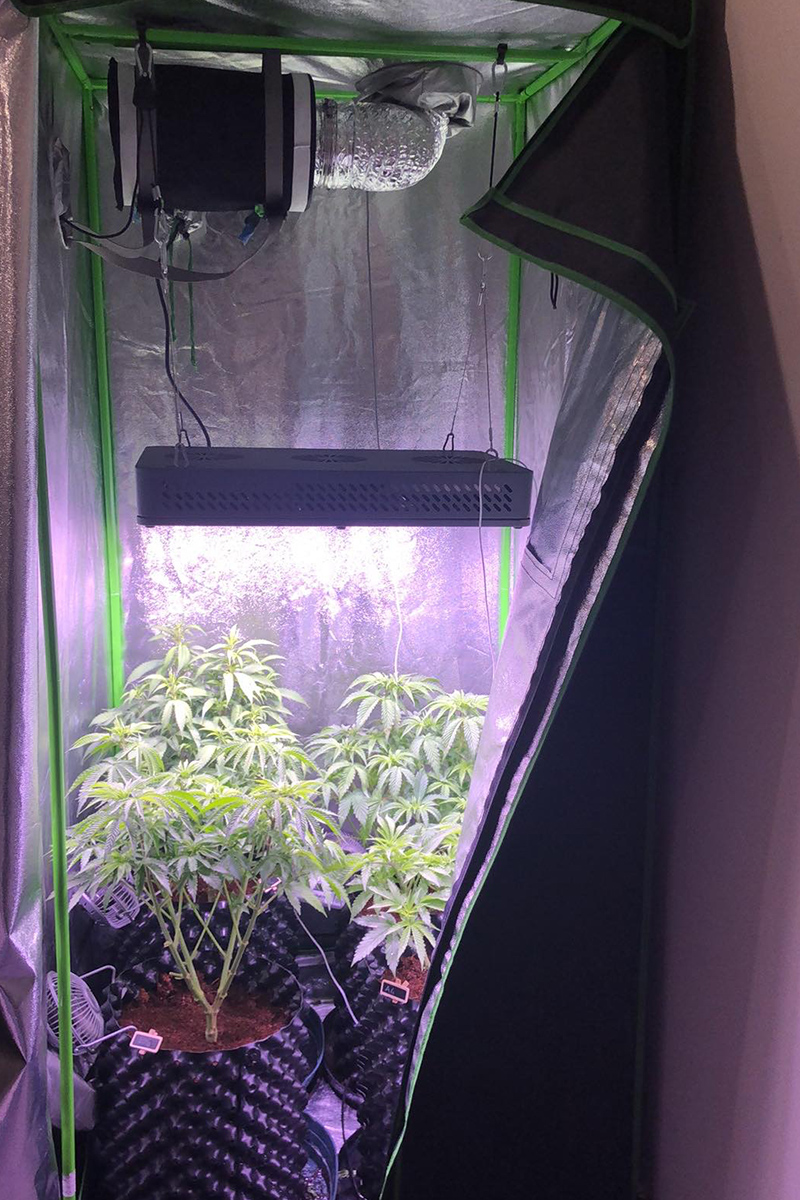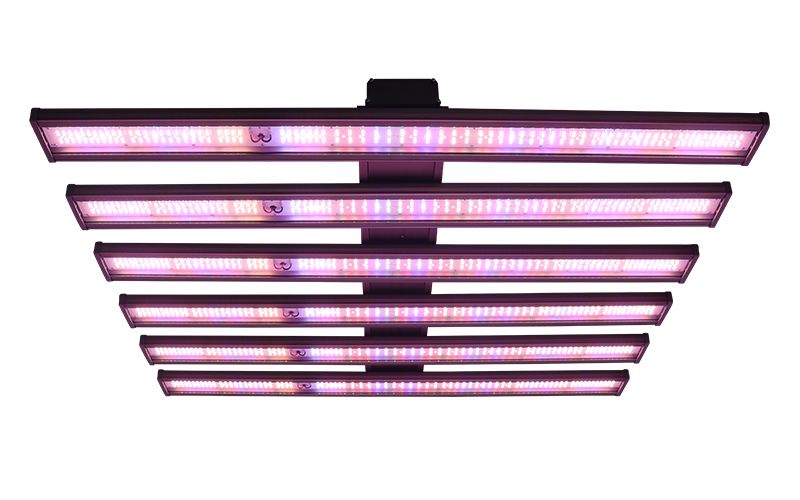
To understand what kind of grow light is needed for a grow tent, you need to understand what a grow tent itself is. This is a special device for growing plants in indoor conditions, consisting of:
1.Growing tent, called a grow tent, is made of durable fireproof material that is sealed enough to create an optimal microclimate inside. The inner surface of the grow tent is reflective, which helps to evenly distribute the light of the grow lights and get the most out of them.
2.A ventilation system that regulates gas exchange in a grow tent. Consists of fans for supply and exhaust air, as well as a filtration system that eliminates intense and unpleasant odors.
3.Growing media: hydroponic system or growbags with drip irrigation system.
4.Lighting - special grow lights.
Maybe the most common grow light is suitable for plants?
An ordinary incandescent light bulb that provides enough light for a person is not at all suitable for growing plants: due to the dim light, photosynthesis will not occur.
If a dim light bulb is lowered closer to the plant, it will dry out and burn it, because, as a rule, it gets quite hot.
grow tent grow lights are different, they differ according to the principle of operation:
Low and high pressure sodium gas discharge grow lights (HPS, HPS);
fluorescent grow lights (ESL, CFL);
LED grow lights (LED).
Also, when deciding which grow lights are best for a grow tent, you should understand that grow lights differ in their lighting spectrum.
Light calculation in a grow tent
Calculation of light in a grow tent is a popular topic on growing sites, you can also find ready-made light calculators (calculation of illumination per area), where it is enough to enter the parameters of the growing area: length and width. So, for an area of 40 by 20, a DNaT 70W is sufficient, or a CFL of 80W, or an ESL of 100W.
It is important to remember that the plant will develop under a 20 watt fluorescent light, but much worse: more slowly and with lower yields.
Here is an approximate calculation of led lighting for a grow tent for different areas, in comparison with gas and LED:
| Square | LED | DNAT | ESL |
| 30×30 cm (0.09 sq.m) | 50 Watt | 70 Watt | 100 Watt |
| 40×40 cm (0.16 sq. m) | 70 Watt | 100 Watt | 150 Watt |
| 50×50 cm (0.25 sq.m) | 115 Watt | 150 Watt | 250 Watt |
| 60×60 cm (0.36 sq.m) | 180 Watt | 250 Watt | 400 Watt |
| 90×90 cm (0.8 sq. m) | 360 Watt | 400 Watt | ————- |
| 110×110 cm (1.2 sq. m) | 530 Watt | 600 Watt | ————- |
| 130×130 cm (1.7 sq. m) | 750 Watt | 1000 Watt | ————- |
How to choose a grow tentlight
grow tent light: which one to choose? Obviously, you need to start from its area: the larger the area, the less effective fluorescent lights are, and on especially large areas, sodium gas-discharge lights will give the greatest effect. When figuring out how to choose a light for your grow tent, it is important to remember that the use of fluorescent (ECL) lights over large areas is impractical. Plants will grow more comfortably if the area is from 0.36 sq.m.
In small areas, the use of ESL lights is justified, the cheapest and easiest to use. However, it is worth taking care of good ventilation and remembering that fluorescent lights get hot.
HPS (sodium gas discharge lights) is the "gold standard" for lighting any area, even the largest. Suitable for both small and large grow tentes. They also get quite hot, requiring a capacitor and ballasts.
The most modern and technologically advanced are LED lights (LED). Today they are quite powerful, consume little electricity and generate almost no heat.
The grow room light that you can buy from Growpro will be of high quality anyway, but it's important to figure out which light you need for your specific needs.
LED grow tent Lights

LED grow tent lights are a modern, technological and sustainable choice. They are LED modules, consisting of many LEDs and a semiconductor through which a current is passed, resulting in the release of photons (light).
These lights use a variety of semiconductor materials to produce radiation at different wavelengths - from infrared to ultraviolet.
Advantages of LED grow lights:
the ability to obtain light of any spectrum required for growing. Ideally, it is necessary to have two blocks of such lights - for the growing and flowering periods, respectively;
LED lights consume little electricity and hardly heat up, so it is easier for the grower to control the climate in the grow tent;
such lights last a long time. However, experienced growers note that the life of an LED light will only be as stated under ideal operating conditions.
Perhaps the only drawback of LED lights is their price. Growpro offers to buy a relatively inexpensive Secret Jardin Tled 26W 55cm Blooming Led light - suitable for additional lighting at the flowering stage, illuminates the lower parts of plants and increases yields. Consists of 144 diodes of 0.18 watts each. Color temperature: 3000K, 2100K, infrared.
The most expensive product in the section is also available - the Growstar 300W spectrum 7.7 led light - high-tech, 300 Watt (in terms of efficiency it is equal to LED lights 750 Watt and DNaT - 1200 Watt). It has two ultra-quiet coolers and a powerful aluminum radiator to maintain a temperature of 30-40 degrees Celsius. The reflection angle is 120 degrees. Chip technology that is much more efficient than panels and UFOs. The light is not directed in all directions, but is collected in a beam, the degree of propagation depends on the distribution lens.
Sodium lights for grow tentes
grow tent sodium lights are the standard for artificial plant lighting. Works complete with:
control gear - throttle and IZU (pulse ignition device);
capacitor.
The DNaT has a flask, inside which there are high pressure sodium vapor, as well as an arc tube made of ceramics with aluminum oxide (resists corrosion from sodium vapor). DNaT is a gas-discharge light, it is started using an IZU and a choke.
The advantage of these lights is in the cost / efficiency ratio, which makes them the leaders in the field of growing box lighting. High luminous efficacy: about 96-150 lumens per watt of power. The standard range of the HPS light is 2100K (optimal for the flowering stage), there are dual spectrum sodium lights. Monochromatic radiation, yellow-orange glow, red spectrum prevails, which is optimal for growing in the autumn-winter period.
Disadvantages of sodium lights:
get quite hot;
slow ignition (the delay can be up to several minutes).
Fitolights for grow tentes
grow tent phytolights are a product of space technologies and are designed for growing plants in conditions of complete absence of light. Modern phyto-lights - LED; among them there are quite inexpensive options: for example, you can buy a phytolight for plants and make a phytolight yourself.
The advantages of phytolights:
serve 5-10 years;
do not generate heat;
do not break with voltage drops;
the intensity of the spectrum does not change over time;
consume little energy, are environmentally friendly and safe.
Types of phytolights:
Bicolor - blue and red, has a beneficial effect on plant growth and activates photosynthesis. Also suitable as a supplement to natural light.
Multispectral - warm white, red, blue, infrared; stimulates flowering and fruiting.
Full spectrum - "personal sun", gives a full harvest in the absence of light.
Ultraviolet radiation also has bactericidal properties, while infrared radiation stimulates plant growth.
Energy saving lights for grow tentes
ESL lights for grow tent (fluorescent) work on the following principle: a spark passes between the electrodes, and ultraviolet radiation arises in mercury vapor, which turns into visible light using a phosphor applied to the inner surface of the tube (a special substance that converts the energy it absorbs into light - luminescent). ESL lights give out about 50-70 lumens per 1 Watt of power.
ECL lights use different types of phosphor (this affects the spectrum of the emitted light):
2700K;
4100K;
6500K.
lights with a "cold" spectrum - 6500K are used for the period of germination and vegetative growth of plants. "Warm" spectrum - 2700K - is necessary for the flowering phase, and "daytime" - 4100K - universal, suitable for the entire plant cycle or for supplementary lighting in any period.
The disadvantage of fluorescent lights is that they heat up quite a lot and the plant, approaching them during the growth process, can dry out and burn out, and for this reason, good ventilation is needed in a grow tent with such lights. The advantage is availability, low power consumption, does not require cooling, can be connected directly to the network, does not require ballasts. Another advantage is a long service life (from 8 to 15 thousand hours).
The Growpro store for growers has a wide selection of ESL lights: from an inexpensive longitudinal compact fluorescent phytolight for a MASTER PL-L 55W / 865 / 4P 1CT grow tent with a power of 55 watts, to a compact fluorescent phytolight Advanced Prostar CFL Grow 200w high power (200 watts).
Energy saving grow tent bulbs are the most popular bulbs especially recommended for beginner growers and small spaces.
CMH lighting
Ceramic Metal Halide Grow lights (CMH / CDM)
CMH is more popular in horticulture. CMH lights have a very wide spectrum of light that looks more like the sun than any other form of HID light. The CMH luminaire can be used as the main light source; primary light for SOG (or Sea of Green) applications or full spectrum secondary light for large flowering operations.
CMH lighting is economical and reliable. The Ceramic Metal Halide System will increase the growth and yield of your plants and reduce your energy costs by up to 70%! CMH bulbs in digital ballast can be used from vegetative state to flowering. Hydrotek has top CMH brands like Philips, Hortilux, Lightspeed, Silverstar and many more.























